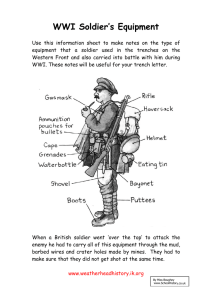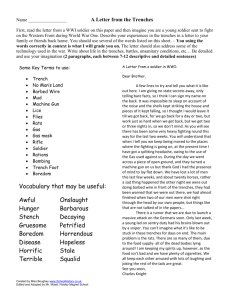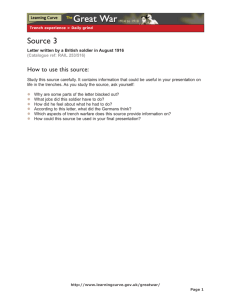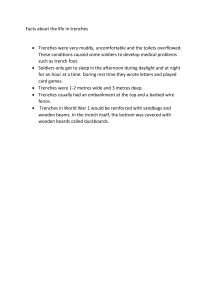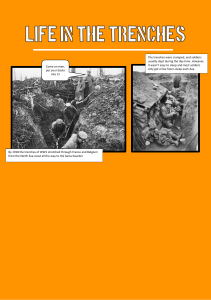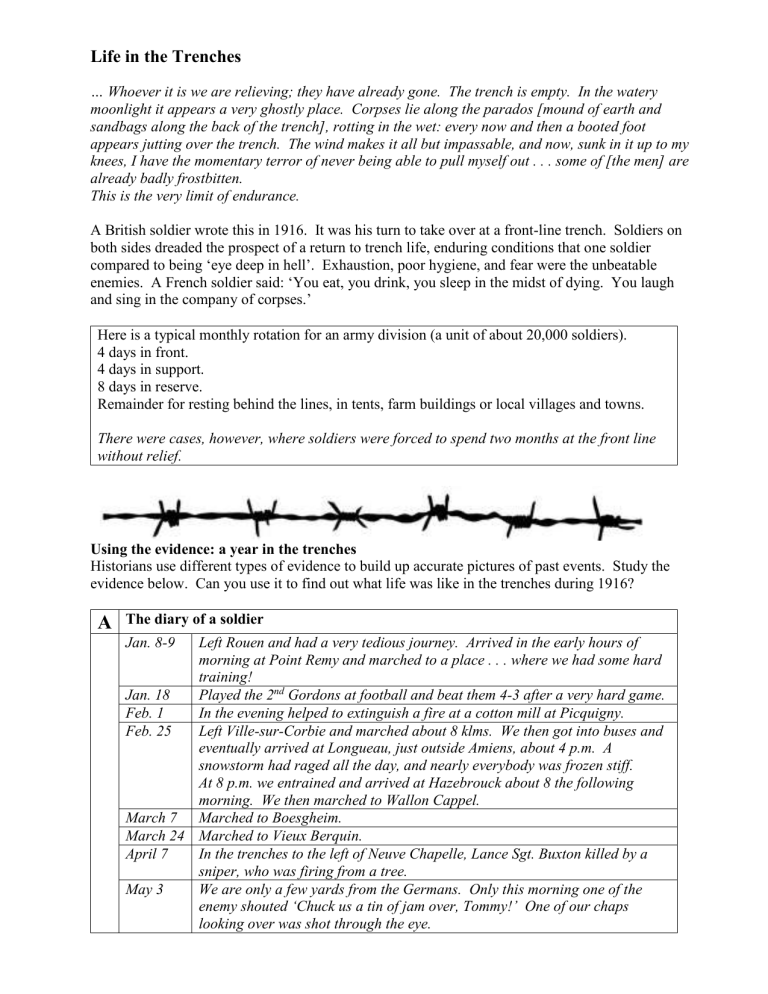
Life in the Trenches … Whoever it is we are relieving; they have already gone. The trench is empty. In the watery moonlight it appears a very ghostly place. Corpses lie along the parados [mound of earth and sandbags along the back of the trench], rotting in the wet: every now and then a booted foot appears jutting over the trench. The wind makes it all but impassable, and now, sunk in it up to my knees, I have the momentary terror of never being able to pull myself out . . . some of [the men] are already badly frostbitten. This is the very limit of endurance. A British soldier wrote this in 1916. It was his turn to take over at a front-line trench. Soldiers on both sides dreaded the prospect of a return to trench life, enduring conditions that one soldier compared to being ‘eye deep in hell’. Exhaustion, poor hygiene, and fear were the unbeatable enemies. A French soldier said: ‘You eat, you drink, you sleep in the midst of dying. You laugh and sing in the company of corpses.’ Here is a typical monthly rotation for an army division (a unit of about 20,000 soldiers). 4 days in front. 4 days in support. 8 days in reserve. Remainder for resting behind the lines, in tents, farm buildings or local villages and towns. There were cases, however, where soldiers were forced to spend two months at the front line without relief. Using the evidence: a year in the trenches Historians use different types of evidence to build up accurate pictures of past events. Study the evidence below. Can you use it to find out what life was like in the trenches during 1916? A The diary of a soldier Jan. 8-9 Left Rouen and had a very tedious journey. Arrived in the early hours of morning at Point Remy and marched to a place . . . where we had some hard training! Jan. 18 Played the 2nd Gordons at football and beat them 4-3 after a very hard game. Feb. 1 In the evening helped to extinguish a fire at a cotton mill at Picquigny. Feb. 25 Left Ville-sur-Corbie and marched about 8 klms. We then got into buses and eventually arrived at Longueau, just outside Amiens, about 4 p.m. A snowstorm had raged all the day, and nearly everybody was frozen stiff. At 8 p.m. we entrained and arrived at Hazebrouck about 8 the following morning. We then marched to Wallon Cappel. March 7 Marched to Boesgheim. March 24 Marched to Vieux Berquin. April 7 In the trenches to the left of Neuve Chapelle, Lance Sgt. Buxton killed by a sniper, who was firing from a tree. May 3 We are only a few yards from the Germans. Only this morning one of the enemy shouted ‘Chuck us a tin of jam over, Tommy!’ One of our chaps looking over was shot through the eye. May 9 June 13 June 21 July 2 Sept 2 Sept 3 Sept 16 Sept 20 Nov 6 Dec 25 B . . . A mine also exploded on our right towards the brick-fields on the other side of the canal. At this place we had fish for tea for when the shell exploded in the canal the fish floated to the top. Raining in torrents. Everybody wet through. If it rains much more we shall have to swim for it. We have started a bugle band and a drum and fife band. During the morning we visited the village, where there was hardly a house standing. . . . We visited the graveyard, where there were some terrible sights. Shells had dropped all about and you could see the bones of people who had been buried for years. Weather very hot. Bombardment still continues. Zero. At last the guns crash. Hell! What a row. You can’t hear yourself speak. What an inferno! Wherever you look you see shells bursting. . . . The sky is one mass of flames. . . . The first wave goes over. What a sight! Men being mowed down like ninepins. . . . The rats are quite a pest here. We have to hang our rations on lines. . . . They are a very hungry lot, as one of them bit the nose of one of our men whilst he was asleep. Back to rest billets. Rejoined my unit after leave. Terrible weather – mud, mud, mud, once more up to the neck in it. Christmas Day, not in the workhouse, but in the trenches, which is worse still. Sgt. James Boardman, Cheshire Regiment, 1916 A photograph of a British trench, 1916 C A photograph of a German underground dug-out, 1916 D A map of the area described. Student: _______________________________________________Class ____ Date _______ Using the Evidence: A Year in the Trenches 1. On the map (source D) find the places that are mentioned in the diary (source A), then calculate the distances that this soldier travelled in 1916 (use a piece of string for measuring winding roads). Now answer the following questions: a. Were soldiers always stationed in one part of the fighting front? Where else would they be? b. How were the troops moved from one place to another? c. Can you give reasons to explain why these troops were moved around so much? d. How typical do you think this soldier’s year was? 2. Compare sources B and C. a. What differences can you see? b. How would you explain these differences? c. Does the diary (source A) agree or disagree with the evidence of life in the trenches provided by the photographs? Refer to specific factual information in the three sources to support your conclusions. 3. Now use all the sources to write a letter home of what life was like in the trenches. Include (a) the dangers, (b) the discomforts, and (c) the pleasures and pastimes. Write your letter on the back of this sheet. Your writing MUST be legible.


